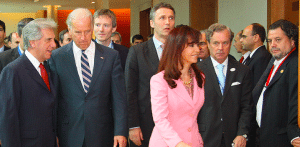Pros and Cons of Quotas for Women in Politics
January 17, 2012
 The Atlantic – Isobel Coleman – Isobel Coleman is the Senior Fellow and Director of the Civil Society, Markets, and Democracy Initiative and Director of the Women and Foreign Policy Program at Council on Foreign Relations. She blogs at “Democracy in Development.”
The Atlantic – Isobel Coleman – Isobel Coleman is the Senior Fellow and Director of the Civil Society, Markets, and Democracy Initiative and Director of the Women and Foreign Policy Program at Council on Foreign Relations. She blogs at “Democracy in Development.”
Pros and cons of requiring national parliaments to include a minimum number of women
Quotas for women seem to be the hot thing in the Middle East these days. Libya just announced a 10 percent quota for women in its new election law. Tunisia used a form of quotas to enhance women’s participation in its recent election. Iraq has used quotas in parliament and just expanded the use of quotas for women to the civil service; Morocco, Egypt, and Jordan have also used quotas. Over the past week, I’ve received several queries from blog readers about quotas: Which countries use them? How do they work? Are they democratic? Are they even effective? These are all big questions, and to answer them thoroughly is beyond the scope of this blog post, so here is just a snap-shot.
 Iraq has a quota reserving 25 percent of parliamentary seats for women. Of the 86 current female parliamentarians, only 5 won enough votes in 2010 to be elected without the quota. Many of the women on party lists were relatives of politicitians or from prominent families, who ran simply to allow the party to fulfill the legal requirement for female representation. Women’s impact on policy and effective governance has been limited. The number of female ministers has in fact declined in the last ten years, largely due to the delicate powersharing arrangements that political parties have reached that divvy up ministerial spots to party leaders (who are men). As I wrote in my book Paradise Beneath Her Feet: How Women are Transforming the Middle East: Iraqi female members of parliament have been regularly insulted by their male colleagues and relegated to working on “women’s issues.” Still, they are in the political mix, and a few have become political role models for a younger generation of aspiring female politicians coming up through the ranks. The government seems happy enough with the quotas that they’ve extended them to new hires in the public sector.
Iraq has a quota reserving 25 percent of parliamentary seats for women. Of the 86 current female parliamentarians, only 5 won enough votes in 2010 to be elected without the quota. Many of the women on party lists were relatives of politicitians or from prominent families, who ran simply to allow the party to fulfill the legal requirement for female representation. Women’s impact on policy and effective governance has been limited. The number of female ministers has in fact declined in the last ten years, largely due to the delicate powersharing arrangements that political parties have reached that divvy up ministerial spots to party leaders (who are men). As I wrote in my book Paradise Beneath Her Feet: How Women are Transforming the Middle East: Iraqi female members of parliament have been regularly insulted by their male colleagues and relegated to working on “women’s issues.” Still, they are in the political mix, and a few have become political role models for a younger generation of aspiring female politicians coming up through the ranks. The government seems happy enough with the quotas that they’ve extended them to new hires in the public sector.
A new quota mandates that women make up 50 percent of new hires in the Health and Education ministries and 30 percent in all other ministries. While this could help ease high levels of unemployment for women, it will also compound the trend in Gulf countries where women are disproportionately employed in the public sector.
Tunisia also implemented a quota for women’s participation in their parliamentary elections at the end of October. Following a closed-list proportional representation system, parties were required to have equal numbers of men and women on their list, alternating candidates by gender. This is known as a “zippered” list, and effectively guarantees that women will win seats, though the quota does not define a percentage of seats allocated for women. Overall, women won 23 percent of seats in parliament. (Forty-two of the 49 women elected are from the Islamist Al Nahda party, which won the lion’s share of the votes.)
A less effective version of this quota system has been implemented in the on-going Egyptian parliamentary elections. Parties were required to include one woman on their list, though they were not required to place the female candidate in a winning position. The results speak for themselves with fewer than 10 women elected to the 498 member parliament as the third and final round of elections wind down. (So far, I’ve confirmed three women elected from the Freedom and Justice Party, one from Al Wafd, and another from the Egyptian Social Democratic Party.)
My botton line on quotas is that they are not a solution for every country, nor are they guaranteed to increase women’s meaningful and effective participation in governance. Quotas bring women’s voices into political systems where they are otherwise excluded, short-cutting a process that can naturally take generations. They have been used successfully by countries ranging from Norway to Rwanda to India. Other factors – like strong political will, enabling women’s freedom of movement, and networks of support for female candidates – significantly strengthen the effectiveness of quotas.
For those interested in learning more about the use and effectiveness of quotas in politics, I recommend the work of Drude Dahlerup. Below are Drude’s pros and cons on quotas.
Pros
- Quotas for women do not discriminate, but compensate for actual barriers that prevent women from their fair share of the political seats.
- Quotas imply that there are several women together in a committee or assembly, thus minimizing the stress often experienced by the token women.
- Women have the right as citizens to equal representation.
- Women’s experiences are needed in political life.
- Election is about representation, not educational qualifications.
- Women are just as qualified as men, but women’s qualifications are downgraded and minimized in a male-dominated political system.
- It is in fact the political parties that control the nominations, not primarily the voters who decide who gets elected.
- Introducing quotas may cause conflicts, but only temporarily.
Cons
- Quotas are against the principle of equal opportunity for all, since women are given preference.
- Quotas are undemocratic, because voters should be able to decide who is elected.
- Quotas imply that politicians are elected because of their gender, not because of their qualifications and that more qualified candidates are pushed aside.
- Many women do not want to get elected just because they are women.
- Introducing quotas creates significant conflicts within the party organization.
This article originally appeared at CFR.org, an Atlantic partner site.
